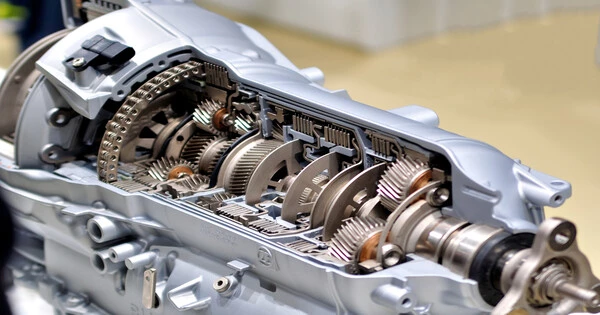Under normal driving conditions, an automated transmission (often abbreviated AT) is a multi-speed gearbox used in automobiles that does not require any input from the driver to change forward gears. It is a form of vehicle gearbox that may change ratios automatically as the vehicle moves, eliminating the need for the driver to shift gears manually. It is one of two basic transmission types used in automobiles, the other being manual transmissions.
The hydraulic automatic gearbox is the most prevalent form of automatic transmission, and it employs a planetary gearset, hydraulic controls, and a torque converter. Continuously variable transmissions (CVT), automated manual transmissions (AMT), and dual-clutch transmissions (DCT) are other types of automatic gearboxes.
The 1904 Sturtevant “horseless carriage gearbox” is often considered to be the first true automatic transmission. The first mass-produced automatic transmission is the General Motors Hydramatic four-speed hydraulic automatic, which was introduced in 1939.
Here are some key features and aspects of automatic transmissions:
- Gear Shifting: A hydraulic torque converter, planetary gearsets, and a complicated system of clutches and bands handle gear changes in an automated transmission. Based on criteria such as vehicle speed, engine load, and throttle position, this system chooses when to shift gears.
- Drive Modes: Automatic transmissions normally have four drive modes: “Drive” (for regular forward driving), “Park” (for motionless), “Reverse” (for backing up), and “Neutral” (for disengaging the transmission from the wheels).
- No Clutch Pedal: Automatic transmissions, unlike manual transmissions, do not have a clutch pedal, therefore the driver does not need to manually engage or disengage the clutch when changing speeds.
- Fuel Efficiency: Modern automatic transmissions have improved fuel efficiency compared to their older counterparts. Many of them come with multiple gears (5-speed, 6-speed, 8-speed, etc.) that allow the engine to operate more efficiently across a range of speeds.
- Manual Mode: Some automatic transmissions have a manual mode or paddle shifters, allowing the driver to manually select gears when desired, providing more control over the transmission’s behavior.
To preserve their longevity and performance, automatic transmissions require routine maintenance such as fluid changes and filter replacements. Because of the intricacy of the transmission mechanism, automobiles equipped with AT are generally more expensive than their manual equivalents. These are known for giving smoother and more enjoyable driving experiences, especially while traveling in heavy traffic or on mountainous terrain.
Automatic gearboxes are prevalent in a variety of vehicles, from compact cars to SUVs and trucks. They are especially popular in areas with heavy traffic since they lessen the physical effort required to drive in stop-and-go traffic.
















